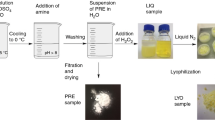Abstract
In this study, the specific coexistence of water and ionic liquid being the lower temperature thermal annealing condition for anatase crystallization of amorphous titania at ambient pressure was found. The test ionic liquids were 1-butyl-3-methylimidazolium hexafluorophosphate and 1-butyl-3-methylimidazolium tetrafluoroborate. After deep investigation, we found that there existed an analogy between our lower temperature thermal annealing treatment system (LTTAT) and hydrothermal treatment system. In LTTAT system, the ionic liquid played an important role in driving surface crystallization of amorphous TiO2 to the anatase phase by retaining a suitable amount of water through a dissolution–crystallization mechanism. We could observe higher hydroxyl group ratio of hydroxylated titanium compound from X-ray photoelectron spectroscopy (XPS) data during initial thermal annealing period. The self-assembly ability of ionic liquid then lead to kinetical dehydration and crystallization of hydroxylated titanium compound around it during the following annealing process. Based upon this proposition, the effects of different types of ionic liquid and its amount, temperature effect, and heating method on anatase crystallinity, characterized by X-ray diffraction (XRD), were investigated. It was found that different temperatures and microwave heating effect were observed for different types of ionic liquid. From these observations, it was pointed out that we could get better anatase crystallinity and good photodegradation performance by using the system containing ionic liquid having higher water-adsorbing ability and microwave heating annealing.







Similar content being viewed by others
References
Burnside SD, Shklover V, Barbě C, Comte P, Arendse F, Brooks K, Grãtzel M (1998) Chem Mater 10:2419. doi:https://doi.org/10.1021/cm980702b
Chiappe C, Pieraccini D (2005) J Phys Org Chem 18:275. doi:https://doi.org/10.1002/poc.863
Antonietti M, Kuang D, Smarsly B, Zhou Y (2004) Angew Chem Int Ed 43:4988. doi:https://doi.org/10.1002/anie.200460091
Zhou Y (2005) Curr Nanosci 1:35. doi:https://doi.org/10.2174/1573413052953174
Jiang J, Yu S, Tao W, Ge H, Zhang G (2005) Chem Mater 17:6094. doi:https://doi.org/10.1021/cm051632t
Zhou Y, Antonietti M (2003) J Am Chem Soc 125:14960. doi:https://doi.org/10.1021/ja0380998
Nakashima T, Kimizuka N (2003) J Am Chem Soc 125:6386. doi:https://doi.org/10.1021/ja034954b
Yoo KS, Choi H, Dionysiou D (2004) Chem Commun 17:2000–2001. doi:https://doi.org/10.1039/b406040g
Yoo KS, Choi H, Dionysiou D (2005) Catal Commun 6:259. doi:https://doi.org/10.1016/j.catcom.2005.01.010
Yoo KS, Lee TG, Kim J (2005) Microporous Mesoporous Mater 84:211–217. doi:https://doi.org/10.1016/j.micromeso.2005.05.029
Galema SA (1997) Chem Soc Rev 26:233. doi:https://doi.org/10.1039/cs9972600233
Hart JN, Cervini R, Cheng YB, Simon GP, Spiccia L (2004) Sol Energy Mater Sol Cells 84:135. doi:https://doi.org/10.1016/j.solmat.2004.02.041
Choi H, Kim YJ, Varma RS, Dionysiou D (2006) Chem Mater 18:5377. doi:https://doi.org/10.1021/cm0615626
Liu Y, Li J, Wang M, Li Z, Liu H, Yang PHX, Li J (2005) Cryst Growth Des 5:1643. doi:https://doi.org/10.1021/cg050017z
Liu YH, Lin CW, Chang MC, Shao H, Yang ACM (2007) (Europacat VIII) 26–31 August 2007 Turku / Åbo, Finland
Dominguez-Vidal A, Kaun N, Ayora-Caňada MJ, Lendl B (2007) J Phys Chem B 111:4446. doi:https://doi.org/10.1021/jp068777n
Katayanagi A, Nishikawa K, Shimozaki H, Miki K, Westh P, Koga Y (2004) J Phys Chem B 108:19451. doi:https://doi.org/10.1021/jp0477607
Salou M, Kiyozumi Y, Mizukami F, Nair P, Maeda K, Niwa S (1998) J Mater Chem 8:2125. doi:https://doi.org/10.1039/a803085e
Yanagisawa K, Yamamoto Y, Feng Q, Yamasaki N (1998) J Mater Res 13:825. doi:https://doi.org/10.1557/JMR.1998.0106
Yu J, Wang G, Chemg B, Zhou M (2007) Appl Catal B 69:171
Pouilleau J, Devilliers D, Groult H (1997) J Mater Sci 32:5645. doi:https://doi.org/10.1023/A:1018645112465
Shin H, Jung HS, Hong KS, Lee JK (2005) J Solid State Chem 178:15. doi:https://doi.org/10.1016/j.jssc.2004.09.035
Cooper ER, Andrews CD, Wheatley PS, Webb PB, Wormald P, Morris RE (2004) Nature 430:1012. doi:https://doi.org/10.1038/nature02860
Tran CD, Paolilacedra SHD, Oliverira D (2003) Appl Spectrosc 57:152. doi:https://doi.org/10.1366/000370203321535051
Wang Y, Li H, Han S (2006) J Phys Chem B 110:24646. doi:https://doi.org/10.1021/jp064134w
Liu W, Zhao T, Zhang Y, Wang H, Yu M (2006) J Solut Chem 35:1337. doi:https://doi.org/10.1007/s10953-006-9064-7
Tompsett GA, Conner WC, Yngvesson KS (2006) ChemPhysChem 7:296. doi:https://doi.org/10.1002/cphc.200500449
Komarneni S (2003) Curr Sci 85:1730
Wilson GJ, Will GD, Frost RL, Montgomery SA (2002) J Mater Chem 12:1787
Murrugan AV, Samuel V, Ravi V (2006) Mater Lett 60:479. doi:https://doi.org/10.1016/j.matlet.2005.09.017
Xu Y, Tian Z, Wang S, Hu Y, Wang L, Ma Y, Hou L, Yu J, Lin L (2006) Angew Chem Int Ed 45:3965. doi:https://doi.org/10.1002/anie.200600054
Acknowledgements
The authors are grateful to Ministry of Economic affair (MOEA) of Taiwan for funding support. A complementary financial support from National Science Council of Taiwan is acknowledged.
Author information
Authors and Affiliations
Corresponding author
Rights and permissions
About this article
Cite this article
Liu, Y.H., Lin, C.W., Chang, M.C. et al. The hydrothermal analogy role of ionic liquid in transforming amorphous TiO2 to anatase TiO2: elucidating effects of ionic liquids and heating method. J Mater Sci 43, 5005–5013 (2008). https://doi.org/10.1007/s10853-008-2740-9
Received:
Accepted:
Published:
Issue Date:
DOI: https://doi.org/10.1007/s10853-008-2740-9




